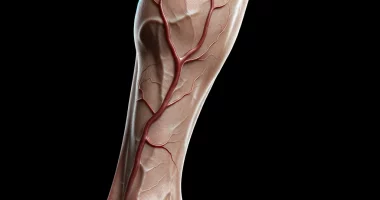Ovarian cyst
What’s that?
An ovarian cyst is a benign mass in the female gonads filled with liquid contents. The fluid volume in the cyst gradually increases, causing it to grow in size. A large formation can compress nearby organs, leading to severe complications.
To avoid an unfavorable outcome and timely diagnose the pathology, a woman should annually undergo preventive examinations with a gynecologist, and when signs of ovarian cysts appear – immediately go to see a doctor.
About the disease
Ovarian cysts in women are widespread. They develop more often in patients of fertile age with irregular menstrual cycles, sometimes in adolescent girls.
A distinction is made between functional cysts that form during the reproductive years, closely related to the cyclic function of the ovaries, and organic benign masses, which are less connected to hormonal features.
It can occur as asymptomatic or with clinical manifestations. Diagnosis is established based on the results of a comprehensive examination, the most important of which is ultrasound.
Treatment is tailored to the mass type, age, and reproductive plans. The patient may be recommended conservative therapy, surgery, or a combination of both.
Types of ovarian cysts
Gynecologists distinguish the following varieties of cystic formations of the ovary:
- A follicular cyst is formed if a maturing follicle has not burst. In most cases, it resolves independently within 3-6 months.
- Corpus luteum cyst – formed when, in the absence of pregnancy, the formed corpus luteum does not undergo reverse development but continues to function for some reason. Like follicular cysts, these formations spontaneously resorb within a maximum of six months.
- Tecaluteal cysts – are caused by pathological shifts early in pregnancy, when the corpus luteum cannot synthesize sufficient progesterone. Such cysts spontaneously pass when gestation ends.
- Endometrioid cyst is a variant of endometriosis in which the endometrial cells lining the uterine cavity are also found on the ovaries. With each menstrual cycle, they undergo corresponding changes, including menstrual bleeding. But the blood has no outlet, so it accumulates in the ovary, forming a cyst.
- A dermoid cyst is a reflection of the pathological course of the embryonic period when cells of the covering epithelium enter the fetal ovary and begin to divide actively. Such formations are located in the capsule and contain fatty tissue, teeth, hair, and bones.
The initial stage of ovarian cancer, which looks like an irregularly shaped cyst, can be distinguished separately. That is why any tumor-like formation in the ovarian area needs an accurate and objective diagnosis to establish the final diagnosis, based on which the upcoming treatment is planned.
Symptoms of ovarian cysts
In some cases, ovarian cysts can be asymptomatic for a long time and discovered accidentally during a gynecological examination or ultrasound scan of the pelvic organs. If symptomatology is present, it includes the following manifestations:
- A feeling of pressure or aching pain in the lower abdomen on the side of the cyst localization (the intensity of pain does not correlate with the size of the cyst). In endometrioid cysts, there is a clear connection of pain with the onset of menstruation.
- Violation of the ovarian menstrual cycle – delayed periods or, conversely, early onset, intermenstrual bleeding.
Ovarian cysts can rupture and twist around their axis. It is accompanied by sudden intense pain in the lower abdomen. In the presence of intra-abdominal bleeding, the pain radiates to the anus (it hurts to sit). Such situations require immediate consultation with a gynecologist and possibly emergency surgical intervention.
Causes of ovarian cysts
The exact causes of this pathology are not established. Scientists identify several factors that increase the likelihood of developing an ovarian cyst. Among them:
- menstrual irregularities;
- early onset of the first menstruation;
- late menopause;
- anovulatory cycles in polycystic ovarian syndrome;
- infertility;
- failure to carry a pregnancy to term;
- chronic inflammation of the pelvic organs;
- aggravated heredity;
- common endocrine disorders.
These factors predispose to the development of dyshormonal ovarian cysts. As a result of the primary weakening of ovarian function and a decrease in estrogen concentration, the level of pituitary gonadotropins, primarily follicle-stimulating hormone, is compensatory increased. This peptide causes active cell division in the ovaries, which may form cystic cavities.
The cause of dermoid cysts of the ovary in women becomes unfavorable factors acting on the mother and fetus at the intrauterine stage:
- alcohol abuse;
- smoking;
- poor ecology
Diagnosis of ovarian cysts
The doctor suspects pathology already at the stage of conversation with the patient and examining her on the gynecological chair
A supplemental diagnostic program may include:
- Clinical blood test – especially indicated if inflammation, rupture, or torsion of the cyst is suspected;
- Biochemical blood test to determine the oncomarker HE-4 and CA-125 (substances produced mainly by cancer cells);
- Ultrasound scan of the pelvic organs with Doppler ultrasonography – to clarify the size and structure of the mass and the nature of blood flow and suggest the most likely type of cyst.
Histologic examination of the cyst removed during surgery is performed in all cases, as it establishes a definitive diagnosis and reliably excludes a malignant process.
Treatment methods for ovarian cysts
Treatment of an ovarian cyst depends directly on its type, the age of the patient, and several other factors. It can be conservative, surgical, or combined. Sometimes, treatment is not carried out at all – the patient needs only dynamic monitoring.
Conservative treatment
Follicular and corpus luteum cysts usually resolve independently within a few months. To prevent their recurrence, the patient may be prescribed hormonal contraceptives that prevent ovulation. These drugs affect the substrate of a potential cyst, the follicle or corpus luteum, preventing their formation.
In case of rupture of the mass and minor intra-abdominal bleeding, when the woman’s condition does not suffer, and dynamic monitoring does not reveal the progression of anemia, treatment is also conservative. The gynecologist prescribes drugs to stop bleeding and, if necessary, NSAIDs.
The first stage of treatment of partial cyst torsion is medication, and if there is no effect from it – surgical intervention. The patient will be prescribed antispasmodics and antiaggregant drugs, as well as infusion therapy. If the woman’s condition normalizes, surgery is not necessary.
An endometrioid cyst is an indication for surgery. However, these formations can reach large sizes, so before surgery, a woman is prescribed a course of hormonal therapy aimed at a slight regression of pathology. As a result, the diameter of the cyst decreases, the operation becomes technically more accessible, and the risk of damage to unchanged tissues is reduced.
Surgical treatment of ovarian cysts
Surgery is recommended in the following cases:
- symptomatic cysts manifested by chronic pelvic pain (a condition in which pain syndrome in the lower abdomen persists for six months or more);
- a ruptured cyst with intra-abdominal bleeding;
- cyst torsion in the absence of effect from conservative treatment;
- large masses;
- dermoid cysts (conventional therapy is a priori ineffective);
- endometrioid cysts;
- Suspicion of the malignant nature of the cystic mass.
In modern gynecology, laparoscopic access is preferred when choosing surgical intervention. It involves only three small punctures in the anterior abdominal wall, which introduce instruments into the abdominal cavity. Such operations are characterized by minimal tissue trauma, insignificant postoperative scar (it is almost invisible), and rapid recovery. Sporadic are open laparotomy operations through the anterior abdominal wall.
The gynecologist tries to preserve healthy tissue as much as possible during surgical intervention. If these conditions exist, the cyst is removed, preserving the ovary and fallopian tube. In cases where this is impossible (large formations, pathological changes in the ovary and/or tube), the surgeon removes the appendages.
All these surgical procedures are performed in more than 700 hospitals worldwide (https://doctor.global/results/diseases/ovarian-cyst). For example, Laparoscopic ovarian cystectomy is done in 32 clinics across Germany for an approximate price of $10.8 K (https://doctor.global/results/europe/germany/all-cities/all-specializations/procedures/laparoscopic-ovarian-cystectomy).
Prevention of ovarian cysts
There is no specific prevention of ovarian cysts. The following measures help to reduce the risks:
- timely treatment of inflammatory diseases of the pelvic organs;
- correction of menstrual disorders;
- timely realization of reproductive function;
- Adequate contraception to prevent abortion.
Since several gynecological diseases have subtle symptoms, only a doctor can detect pathology. Therefore, it is recommended that all women should visit a gynecologist once a year for preventive examinations, even in the absence of complaints.
Rehabilitation after surgery
After laparoscopic removal of ovarian cysts, the patient spends 1-3 days in hospital. During this time, patients can move around actively and eat food. Gynecologists monitor the course of the postoperative period and the woman’s general condition.
Before discharge, dressings, control examination, and, if indicated, ultrasound of the pelvic organs are performed. At home, the patient is allowed light physical activity. However, it is required to observe sexual rest until complete healing of the wounds, which will inform the doctor during repeated examinations.



